For citation, please use:
Safranchuk, I.A., Nesmashnyi, A.D. and Chernov, D.N., 2023. Africa and the Ukraine Crisis: Exploring Attitudes. Russia in Global Affairs, 21(3), pp. 159–180. DOI: 10.31278/1810-6374-2023-21-3-159-180
The Ukraine crisis has become a complex global phenomenon. The literature on this subject can be divided into several blocks, each with a different focus. The last few decades have been marked by heated discussions among political scientists about the state and the future of the world order (Ikenberry, 2018; Mearsheimer, 2019; Karaganov, 2019; Safranchuk and Lukyanov, 2021). Since the crisis is directly related to these discussions, representatives of different schools are trying to find proof for their forecasts in the current events (Ikenberry, 2022; Walt, 2022; Mearsheimer, 2022; Sakwa, 2023; Barabanov et al., 2022). A separate block contains research on the global consequences of the Ukraine crisis. Much attention is paid to security issues (Nesmashnyi, 2023), including food security (Bartenev, 2022; Salikhov, 2023), as well as financial and economic problems (Romanova, 2022). Many publications explore the positions of individual countries. Naturally, attention is riveted on major non-Western powers such as India (Jagtiani, Wellek, 2022; Kapoor, 2023) and China (Zuenko, 2022; Carlson, 2022). There are also works on the positions of various small and medium-sized states (Vorontsov, 2022; Dharmaputra, 2022; Nelidov, 2022; Nagy and Ngyen, 2023), including African ones (Azikiwe, 2022; Loshkarev, 2022; Gachicheladze, 2022; Shheglovin, 2022; Balmasov, 2022, Shafie, 2022), where the case-study method prevails.
A separate block consists of studies using quantitative analysis methods aimed not at analyzing the positions of individual states, but at drawing a holistic picture in order to compare the positions of multiple states (Ngo et al., 2022; Vahdat-Nejad et al., 2022; Safranchuk et al., 2022; Foa et al., 2022; The Economist, 2023; Panin, 2023). What makes such research complicated (which apparently can explain the scarcity of such works to date) is that it requires the collection of reliable data on commensurable parameters for many countries.
The research group of the MGIMO Institute for International Studies analyzes the global reaction to the Ukraine crisis. The peculiarity of the method used is that, although it does not provide a detailed description of the position of each individual country, it allows juxtaposing the positions of states with each other. In other words, it helps create a coordinate system for the international reaction to the Ukraine crisis and map the positions of individual countries, as well as their clusters (this is a mapping that reflects not the geographical proximity of states, but the closeness or similarity of their positions with regard to the Ukraine crisis). This article presents an analysis of the international reaction to the Ukraine crisis with a focus on African states.
Methodology
The goal of our analysis is to represent the positioning of countries towards the Ukraine conflict. To this end, we use several measurement and analysis algorithms which are described in this section. The analysis and measurements are made for two time periods (February 24, 2022‒August 31, 2022, and September 1, 2022‒February 24, 2023) to track the dynamics of countries’ alignment.
To measure the position of each country in relation to the Ukraine conflict, we use several data sources. The first component of our research data is the results of countries’ voting in the UN General Assembly. All UN member states are included in the analysis. However, due to data restraints, our analysis includes only governments represented in the UN General Assembly, even if they do not exercise effective territorial control over significant parts of their territoryies (which is an important distinction of such countries as Libya, Afghanistan, and Yemen).
We obtained voting results for several UNGA Resolutions: A/ES-11/L.1 (UN, 2022a), A/ES-11/L.2 (UN, 2022b), A/ES-11/L.3 (UN, 2022c), A/ES-11/L.5 (UN, 2022d), A/ES-11/L.6 (UN, 2022e), A/ES-11/L.7 (UN, 2023). The first three resolutions are included in the dataset for the first period and the second set of three resolutions is included in the second time period. Voting is treated as a categorical variable which is coded as follows: 1 – vote in favor, 0 – abstention or no vote, −1 – vote against.
Another component of our dataset is adherence to sanctions as a tool for putting pressure on Russia. The introduction of sanctions against Russia is included as a binary variable where 1 – sanctions were introduced, 0 – sanctions were not introduced.
Military aid to Ukraine is one of the most significant variables determining the attitude towards the conflict. We include military aid both as a categorical and a quantitative variable. The quantitative variable is the volume of military shipments as a percentage of nominal national GDP.[1] The categorical variable is introduced to account for some uncertainty related to military shipments of some statements. The coding is as follows: 1 – official military shipments to Ukraine, 0.3 – uncontested rumors of military shipments, 0.1 – participation in Rammstein meetings without any evidence of shipments.[2]
Finally, we also included a measure of national media sentiment in relation to the Ukraine conflict. This variable is calculated as a difference in sentiment[3] between two samples of messages of the national media with two groups of keywords: “Putin/Russia & Ukraine” and “Biden/United States & Ukraine” (GDELT, 2023).
Another dataset is used in regression and correlation analysis. We use several independent variables that help determine a country’s alignment in the Ukraine conflict: absolute military expenditure (SIPRI, 2022), Fragility States Index (Fund for Peace, 2023), Human Development Index, GDP, PPP, GDP per capita (World Bank, 2023), the number of Western sanctions introduced against a country (Attia and Grauvogel, 2022), and export from and import to Russia and Ukraine (UN Comtrade Database, 2023).
The remainder of the section essentially retraces the steps that we followed when processing and analyzing our data.
To simplify the data structure for visualization and further interpretation of countries’ positions and to deal with the high correlation among dependent variables, we apply dimensionality reduction. Specifically, we use factor analysis for mixed data. Essentially, the method implies the partitioning of the dataset into two subgroups: with quantitative and qualitative variables. After the partitioning, multiple correspondence analysis (MCA) is applied to the qualitative variables and principal component analysis (PCA) is applied to quantitative variables.
For the MCA, we use Table X with qualitative variable J which is binarized to create a completely disjunctive table (Salkind and Rasmussen, 2007). We calculate all the grand total for all entries from the table and name it and the probability matrix Z = N−1X. We named the row sum of Z as r and the column sum as c for which we have Dr = diag r , Dc = diag c (Salkind and Rasmussen, 2007). The factor scores were obtained through singular value decomposition with the following formula (Salkind and Rasmussen, 2007):
Dr −1/2 (Z − rcT) = P δ QT
The PCA involves finding linear combinations of the given variables from Table X that would maximize the variance. The solution can be written as follows:
Z = XW
where W is a vector of factor loadings which are chosen to maximize variance. W is usually represented by an eigenvector which essentially satisfies the maximum variance criterion.
Factor scores for quantitative and qualitative variables are then combined, which in matrix form can be put as follows (Sayadi et al., 2021):
FAMD = PCA + MCA
After having obtained the factor loadings, the original data table that represents various policies and actions of a country in relation to the Ukraine crisis is reduced to a two-dimensional space which simplifies the visualization of the components.
This simplified data structure is further used to discern groups of states with common positions in relation to the Ukraine crisis. To distribute our data points, which represent countries, into groups, we use clustering by the k-means method with 5 clusters.
The method is based on the partitioning of x observations into n clusters. Each observation xi is assigned to a cluster with the cluster mean with the nearest Euclidean distance. The cluster mean is recalculated for each step according to the following formula:

where Ci is the number of observations in cluster i, and µi represents the mean of cluster i.
The algorithm stops when the partitioning of data shows no longer changes. In k-means, we seek to minimize the within-cluster sum of squares (WCSS):

The next task concerns the analysis of the relationship between the variables and the position of a country in relation to the Ukraine conflict. This requires the construction of a single index that would represent a country’s alignment. The index, which we name the Ukrainian Conflict Alignment Index (UCAI), is computed as a difference in Euclidean distance of each country from Ukraine and from Russia:

where xc and yc represent the position of country c in the two-dimensional space (FAMD results), xru , yru and xukr , yukr represent the position of Russia and Ukraine. The resulting index varies from −8 to 8, where the maximum means full convergence with the Russian position. The index is calculated separately for two periods.
To conduct the analysis of the relationships, we use two separate methods. The Pearson correlation coefficient is used to study basic relations between variables and discern some significant associations in the data structure. Correlation analysis is applied only to the first period.
The Pearson correlation coefficient is calculated as follows:

where , xi , yi represent observations for variables of interest, and x, y, represent the means of respective variables.
To achieve a deeper understanding of the relationships and to test their robustness, we use a mixed effects regression with a random intercept. Mixed effects regression is an extension of the regression analysis technique which accounts for the hierarchical structure of the data.
Specifically, the regression equation is written as follows:
yij = β0 + β1 xij + ui + εij
where yij is the response observation for i − the measurement of j − the entity, β0 is the intercept, β1 is the slope coefficient, xij is the predictor observation for i − the measurement of j − the entity, ui is the random intercept for i − the entity, ui ~ N(0,σ 2), and εij is the regression error term.
In our study, the specifications of regression models are deliberately varied to test different combinations of variables and track changes in coefficients and their significance.
Africa and the Ukraine Crisis: Main Attitude Groups
The results of cluster analysis permit to divide the reactions of countries to the Ukraine crisis into five attitude groups: a hardline anti-Russian stance, a moderate anti-Russian stance, a neutral stance, sympathetic with Russia, and aligned with Russia. The identified clusters and the distribution of African countries among them for the two time periods (February-August 2022 and September 2022-February 2023) are presented in Fig. 1 and Fig. 2.
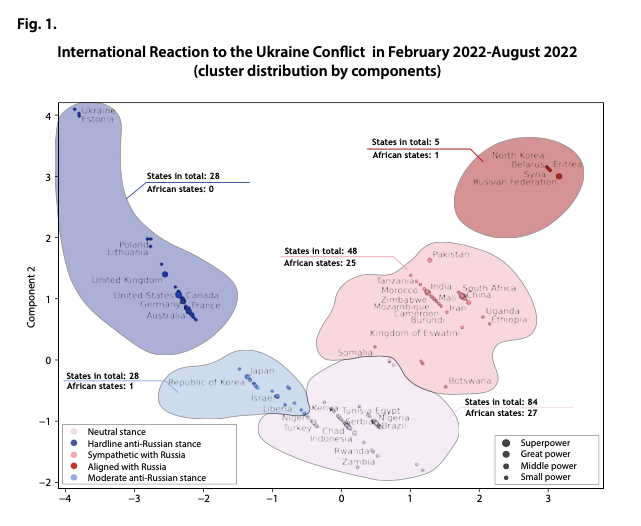

In the first period, only one African country—Liberia—demonstrated a moderately anti-Russian stance, although close to the position of “neutral” countries. In the second period Liberia joined the neutral cluster, but with a position leaning towards the West. One country, Eritrea, remained “aligned with Russia” in both periods. Mali, on the other hand, moved from the cluster of countries “sympathetic with Russia” to the cluster of states “aligned with Russia.” Yet the main result of this part of the analysis is that most African countries fall into the “neutral” cluster, with Africa making up almost one-third of this group (in both periods under consideration). There are slightly fewer African states in the cluster of countries sympathetic with Russia, though Africa makes up half of that cluster in both periods.
The above data show that African countries do not have a unique approach to the crisis, their positions are similar to many Latin American and Asian countries. Together with them, they form an important part of the World Majority.
Shifts in the Positions of African States
The positions of African states are not static. Eleven countries moved from one cluster to another across the two periods. These were mostly movements between the clusters of “neutral” countries and countries “sympathetic with Russia” in both directions. On average, for the whole of Africa, as we have already said, the number of countries in each cluster changed just slightly between the first and the second periods.
Based on the data presented in Fig. 1 and Fig. 2, we can infer the stability of African countries’ attitude towards the Ukraine crisis with some shifts towards Russia, as Liberia moved from the cluster of countries with a moderate anti-Russian position to the cluster of neutral countries, and Mali switched from being “sympathetic” to being “aligned” with Russia. However, a more detailed analysis shows that the overall picture looks different: in the second period, most African countries moved away from Russia.
The change between the first and the second periods is shown in Fig. 3. Nineteen countries became closer to Russia, and 34 moved away, and the average change of the latter group was higher than that of the former. In other words, the group of African countries which drifted away from Russia did so more actively than the other that moved closer towards it.

Note: Colors in the column correlate with the colors of the clusters to which countries belong according to the cluster analysis. If a country changed its cluster between the first and the second periods, it appears in two colors (see Fig. 1 and 2 for color/cluster correlation).
This is supported by the calculations for all African countries on average, presented in Fig. 4. It clearly shows that in the first period (the left part of the graph) almost a quarter of African countries was in the upper spectrum of the cluster of states “sympathetic with Russia,” that is, in the part that is closer to the Russian position, with only one country in the part bordering on the neutral position. In the second period, the situation reversed: only six percent of states remained in the part of the “sympathetic” cluster which is closer to the strong supporters of Russia, while the number of countries closer to the “neutral” cluster increased to 15 percent. The middle part of the cluster of sympathetic countries changed much less: one-fifth of African countries in the first period and a quarter in the second. The same dynamics is observed among the “neutral” countries. The upper part of this cluster, bordering Russian sympathizers, shrank from one-fifth of African states to zero, while the lower part, bordering on a moderately anti-Russian position, increased from six percent to a quarter of all African states. The middle part of the “neutral” cluster is more stable and remained almost unchanged at about a quarter of African countries. This allows us to conclude that African countries gravitate towards a certain middle position even within the same cluster, and that a more moderate approach is more lasting than a stronger pro-Russian one.

African Countries and Great Powers
A comparison of the closeness of African states’ positions to the views of great powers (Russia, U.S., China, France, UK, Germany, India) produced interesting results (see Fig. 5).
The position of African states is closest to the position of India, and, to a lesser degree, China. The obvious outsider is the United States. However, for all African states on average, and for African states from the “neutral” cluster in particular, the positions of the three European powers are still closer than the position of Russia.
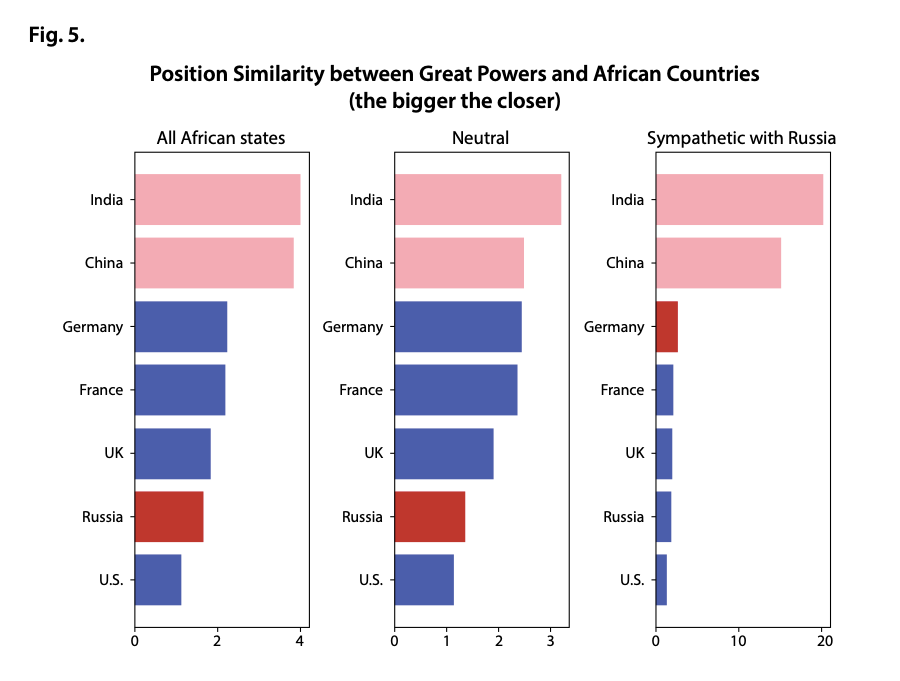
Note: Colors in the columns correlate with the colors of the clusters to which countries belong according to the cluster analysis of the data for the period from September 2022 to February 2023 as shown Fig. 2. Proximity values are also calculated for the second period.
A more detailed analysis shows that in the second period African countries (on average) slightly drifted away from Russia but even more so from the United States. The causes of this shift are of particular interest. As noted above, although the views of individual African countries transformed substantially, their average position changed just slightly (because changes in individual countries were multidirectional). Therefore, the shift in the closeness to Russia or the United States occurred not so much because the positions of the African states had changed, but because Russia and especially the United States had altered their own approaches. In the period from September 2022 to February 2023, Washington’s military aid to Ukraine amounted to 0.13 percent of American GDP, which made the United States the main (in this period) supplier of weapons to Ukraine not only in absolute quantitative terms, but also in relative ones.


The situation with the European great powers is slightly different. Their positions in the second period changed slightly, so even a small shift away from Russia in the average position of African countries was enough for them to come closer to Germany, France, and the UK. However, this drift is insignificant, it does not set a trend (at least the available data do not indicate that), and there is no reason to conclude that Africa is really getting closer to Europe on the “Ukrainian issue.”
Unsurprisingly, all African countries, including those in the “neutral” cluster, are closest to China and especially India. It is noteworthy that particularly close to India and China are the states “sympathetic with Russia.” Formally, there is a simple explanation for that: the two great powers of the East are themselves in the cluster of countries “sympathetic with Russia.” But in political terms, this gives grounds for a conclusion that is quite paradoxical at first glance: in practical terms, being close or becoming closer to Russia means being even closer or becoming even closer to China and especially to India. Therefore, it is also true that if China and India do not change their stance with regard to the position of Russia (at least do not drift away), coming closer to India and China will simultaneously bring other countries, including African ones, closer to Russia.
Determinants of African Countries’ Positions
With cluster analysis, we compared the reaction of different countries to the Ukraine conflict. However, some questions remain: Why certain states, in this case African, assume such positions, and what determines their attitude to the Ukraine conflict and the parties involved in it? To answer these questions, we have carried out correlation and regression analyses with the following independent variables: military spending, Fragile States Index, Human Development Index, Western sanctions, exports to and imports from Russia, exports to and imports from Ukraine, GDP, PPP, and GDP per capita. With these analyses we have tested the hypothesis that the position of African states is determined by the material characteristics. The results of the analyses are presented in Tables 1, 2, and 3.
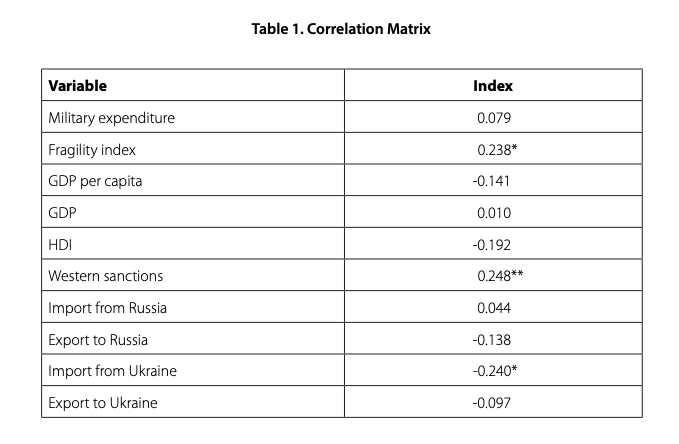
The analysis has revealed several statistically significant, albeit weak, relationships. For example, there is a fairly consistent relationship between the introduction of Western sanctions against a country and its solidarity with Russia. Countries with large military spending and countries with higher instability index scores occupy a position closer to Russia’s. There is also a negative relationship between the volume of imports from Ukraine and proximity to the Russian position. The remaining variables included in the analysis did not yield reliable or significant evidence.
The results we have obtained provide a rather logical picture showing the influence of material (as opposed to political and international) determinants. Sanctions imposed by the West lead to African states’ solidarity with Russia. Significant exceptions are Somalia and Libya, but sanctions were imposed not against their governments and elites supporting them, but against other groups.
With certain reservations, we can consider an increase in military spending an indicator of a country’s independence and sovereignty, and its readiness to use force to defend its interests. Hence these countries may view the use of force as more permissible. Although such an interpretation is generally correct, a closer look reveals an important nuance. The correlation between the level of military spending and support for Russia is more evident not in the countries where military expenditures are high, but in those where they are low. These are the Seychelles, Mauritius, Sierra Leone, and Cabo Verde. Small states are vulnerable to Western pressure during voting in the UNGA and generally cannot afford to pursue independent policies. Countries with a low level of military spending stay farther from Russia. This is how the observed correlation between the level of military spending and closeness to Russia forms.


On the other hand, Russia is supported by more unstable regimes that depend on its support to consolidate their own power. For example, countries that sympathize with Russia include Sudan, the Central African Republic, and Ethiopia (countries with a high level of internal instability). This indicator is also quite high in Eritrea and Mali, which are strong supporters of Russia. And yet, there are also significant exceptions: more fragile states such as Libya, Chad, Nigeria, and Niger keep aloof and occupy more neutral positions.
Finally, the more a country depends on trade with Ukraine, the farther it is from the Russian position, which is quite natural. This is true mainly of countries whose imports from Ukraine are quite big. Countries dependent on the import of Ukrainian grain, including Gambia, Djibouti, Tunisia, Egypt, Somalia, and Mauritania, gravitate towards the neutral camp (the exception is Togo, which, despite a significant amount of trade with Ukraine, stays close to the cluster of those “sympathetic with Russia”). As for countries whose trade with Ukraine is close to zero, they can be found in all groups, including “neutral” and “sympathetic with Russia.”
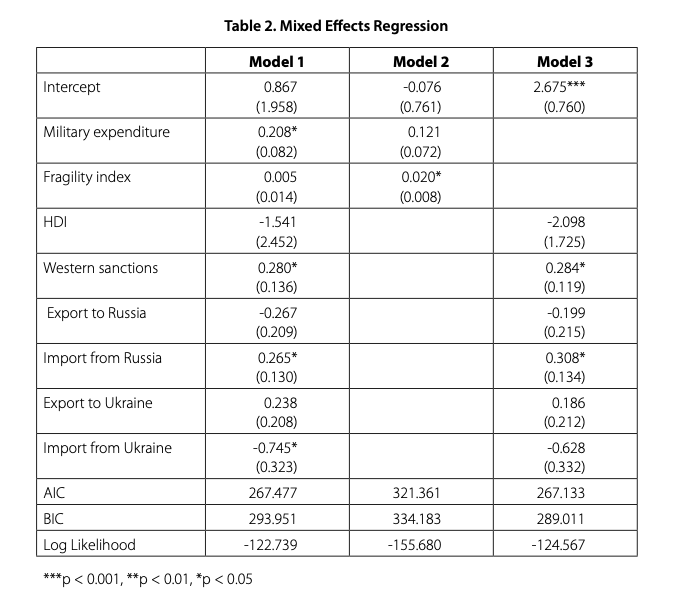
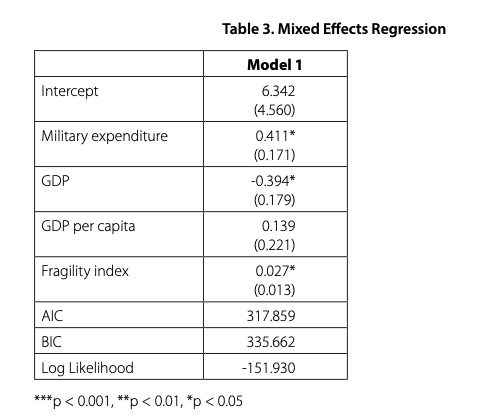
We must say that the established correlations are relatively weak (perhaps, with the only exception that the sanctioned governments are inclined to show greater support for Russia). On the one hand, this is due to technical problems in using quantitative methods for analyzing available data. But it can also be concluded that the positions of African countries are not determined solely by “material” factors. We have established some correlations of this kind above, but still “material” determinants do not prevail. For many countries, the position on Ukraine is a matter of choice, a product of political and perhaps situational decisions.
Some Generalizations
Major international actors are sensing that shifts in the approaches of many African states are possible, but it is necessary to work with their elites. So, external powers are set to fight. Our research confirms that there are reasons to believe this perception is close to truth: African countries’ attitude is not strictly determined by material factors, but is largely the result of their political choice, which means it can change.
Countries that have strained relations with the West (Sudan, Eritrea, Mali, Central African Republic, Zimbabwe) gravitate towards Russia. There is no need for Russia to fight for them because the West, even despite its pressure, is unlikely to be able to reverse their position (the latter is possible only due to internal coups or regime change). So, the West will ramp up pressure to punish them rather than enticing them, and Russia will have to mitigate the consequences of Western blows not with a view to keeping these countries in its orbit, but out of general solidarity. Small countries, vulnerable to political and material coercion, give in to the American pressure when it comes to voting in the UNGA. The West gets them relatively easily as “extras” in its game of keeping up the international chorus condemning Moscow. Russia is hardly capable of effectively luring them away. An attempt to exert counter-pressure on them and put them “between the rock and the hard place” is unlikely to produce the desired result, but is likely to cause a negative reaction from the rest. Many other African countries can change their positions, and there will be a struggle for them.
However, attempts to encourage changes in the positions of African states by carrot and stick have limits. As shown above, the distancing of African countries from both Russia and the United States was not the result of policy reformulation by African countries, but primarily because Russia and the United States themselves had changed and radicalized their approaches. Apparently, the “struggle for Africa” is not only about influencing African countries, but also, incredible as it may sound to the apologists of international relations as great power politics, about adjusting oneself to Africa and finding such an international position that would accommodate the interests and worries of African states.
The research is funded by the Russian Science Foundation, Project 22-18-00664 (https://rscf.ru/project/22-18-00664/). The authors express their gratitude to MGIMO research interns Svyatoslav Arov, Roman Zhuravlev, Yevgenia Komarova, Sergei Kuznetsov, and Anna Semenova for assistance in collecting and processing the data.
Attia, H. and Grauvogel, J., 2022. International Sanctions Termination Dataset. Harvard Dataverse. Available at: https://dataverse.harvard.edu/dataset.xhtml?persistentId=doi:10.7910/DVN/SVR5W7 [Accessed 15 April 2023].
Azikiwe, A., 2022. Reaktsiya Afriki na ukrainsky krizis [Africa’s Reaction to the Ukraine Crisis]. Valdai Discussion Club, 15 July. Available at: https://ru.valdaiclub.com/a/highlights/reaktsiya-afriki-na-ukrainskiy-krizis/?ysclid=lgg5kolr5i251796629 [Accessed 1 May 2023].
Balmasov, S.S., 2022. Otnoshenie Alzhira k spetsialnoi operatsii Rossii na Ukraine [Algeria’s Attitude towards Russian Special Operation in Ukraine]. Institute for Middle East Studies. Available at: http://www.iimes.ru/?p=83885&ysclid=lgg6jespu7695589962 [Accessed 1 May 2023].
Barabanov, O., Bordachev, T., Lisovolik, T. et al., 2022. Mir bez sverkhderzhav [A World Without Superpowers]. Valdai Discussion Club, October. Available at: https://ru.valdaiclub.com/a/reports/mir-bez-sverkhderzhav-ezhegodnyy-doklad/ [Accessed 1 May 2023].
Bartenev, V., 2022. The Impact of Sanctions on Food Security: Traditional and New Dimensions. Pathways to Peace and Security, (2), pp. 11-37.
Dharmaputra, R., 2022. Understanding Indonesia’s Response to Russia’s War in Ukraine. Journal Of Global Strategic Studies, 2(1), pp. 115-128.
Foa, R.S., Mollat M., Isha, H., Romero-Vidal, X. et al. A World Divided: Russia, China and the West. Centre for the Future of Democracy, October. Available at: https://doi.org/10.17863/CAM.90281 [Accessed 1 May 2023].
Fund for Peace, 2023. Fragile State Index. Fund for Peace. Available at: https://fragilestatesindex.org/excel/ [Accessed 15 April 2023].
Gachicheladze, Z., 2022. Pozitsiya YuAR po ukrainskomu krizisu [South Africa’s Position on the Ukraine Crisis]. Russian International Affairs Council, 13 May. Available at: https://russiancouncil.ru/analytics-and-comments/columns/africa/pozitsiya-yuar-po-ukrainskomu-krizisu/?ysclid=lgg5is5sft159151956 [Accessed 1 May 2023].
GDELT, 2023, GDELT Analysis Service. GDELT. Available at: https://www.gdeltproject.org/data.html#gdeltanalysisservice [Accessed 19 April 2023].
Ikenberry, G.J., 2018. The End of Liberal International Order? International Affairs, 94(1), pp. 7-23.
Ikenberry, G.J., 2022. Why American Power Endures: The US-Led Order Isn’t in Decline. Foreign Affairs, 101, pp. 56-66.
Kapoor, Nivedita, 2023. Russian Grand Strategy: Why It Stalls in Relations with India. Russia in Global Affairs, 21(1), pp. 174-198.
Karaganov, S.A., 2019. Departure of Military Superiority of the West, and Geo-Economics. Polis. Political Studies, (6), pp. 8-21.
Kiel Institute, 2023. Ukraine Support Tracker Data. Kiel Institute. Available at: https://www.ifw-kiel.de/publications/data-sets/ukraine-support-tracker-data-17410/ [Accessed 22 April 2023].
Loshkarev, I., 2022. Reaktsiya stran Afriki na spetsialnuyu voennuyu operatsiyu na Ukraine [African Reactions to the Special Military Operation in Ukraine]. Russian International Affairs Council, 22 April. Available at: https://russiancouncil.ru/analytics-and-comments/analytics/reaktsiya-stran-afriki-na-spetsialnuyu-voennuyu-operatsiyu-na-ukraine/?ysclid=lgg5oyd24a714750152 [Accessed 1 May 2023].
Mearsheimer, J.J., 2019. Bound to Fail: The Rise and Fall of the Liberal International Order. International Security, 43(4), pp. 7-50.
Mearsheimer, J., 2022. The Causes and Consequences of the Ukraine Crisis. The National Interest, 23 June. Available at: https://nationalinterest.org/feature/causes-and-consequences-ukraine-crisis-203182 [Accessed 1 May 2023].
Nagy, S.R. and Nguyen, H., 2023. Deterrence, Resilience, and Engagement: Tokyo’s Response to the Ukraine War and Russia-China Alignment. Stosunki Międzynarodowe–International Relations, 3(4).
Nelidov, V.V., 2022. Ukrainian Crisis in Japan’s Domestic Political Discourse. Japanese Studies in Russia, (4), pp. 108-122.
Nesmashnyi, A.D., 2023. European Security Crisis and U.S. Hegemony: Reversing the Decline? Russia in Global Affairs, 21(1), pp. 132-152.
Nesmashnyi, A., Zhornist, V. and Safranchuk, I., 2022. International Hierarchy and Functional Differentiation of States: Results of an Expert Survey. MGIMO Review Of International Relations, 15(3).
Ngo, V.M., Huynh, T.L., Nguyen, P.V., and Nguyen, H.H., 2022. Public Sentiment towards Economic Sanctions in the Russia-Ukraine War. Scottish Journal of Political Economy, 69(5), pp. 564-573.
Panin, N., 2023. Praktika golosovaniya gosudarstv Afriki yuzhnee Sahary v Generalnoi Assamblee OON: poslednie tendentsii i osnovnye strategii [Subsaharan Voting Practices in the UN General Assembly: Current Trends and Principal Strategies]. Russian Council, 30 March. Available at: https://russiancouncil.ru/activity/workingpapers/praktika-golosovaniya-gosudarstv-afriki-yuzhnee-sakhary-v-generalnoy-assamblee-oon-poslednie-tendents/ [Accessed 1 May 2023].
Romanova, T.A., 2022. Breakdown of EU-Russia Transnational Ties: Causes and Consequences. Russia in Global Affairs, 20(3), pp. 39-58.
Safranchuk, I.A., Chernov, D.N., Nesmashnyi, A.D. and Zhornist, V.M., 2022. A World Divided: The Ukrainian Crisis in a Regional and Global Context. Policy Brief. Institute for International Studies, October. Available at: https://mgimo.ru/upload/iblock/6a6/vozvm1cpzie78br8xqrr766b49sqi31j/world-divided-ukrainian-crisis.pdf [Accessed 1 May 2023].
Safranchuk, I.A. and Lukyanov, F.A. 2021. The Modern World Order: Structural Realities and Great Power Rivalries. Polis. Political Studies, (3), pp. 57-76.
Sakwa, R., 2023. Crisis of the International System and International Politics. Russia in Global Affairs, 21(1), pp. 70-91.
Salikhov, M.R., 2023. Food/Energy Security and Global Markets. Russia in Global Affairs, 21(1), pp. 111-113.
Salkind, N.J. and Rasmussen, K. (eds), 2007. Encyclopedia of Measurement and Statistics. Thousand Oaks, Calif: SAGE Publications.
Sayadi, S. et al., 2021. Secure Distribution of Factor Analysis of Mixed Data (FAMD) and Its Application to Personalized Medicine of Transplanted Patients. In: L. Barolli, I. Woungang, and T. Enokido (eds.) Advanced Information Networking and Applications. Cham: Springer International Publishing, pp. 507–518.
Shafie, S.M., 2022. SRA Poll: Russia’s Invasion of Ukraine. Somalia Researchers Association. Available at: https://www.researchgate.net/publication/359018305_SRA_Poll_Russia%27s_Invasion_of_Ukraine [Accessed 1 May 2023].
SIPRI, 2022. SIPRI Military Expenditure Database. SIPRI. Available at: https://www.sipri.org/databases/milex [Accessed 15 April 2023].
The Economist, 2023. Who Are Russia’s Supporters? The Economist, 31 March. Available at: https://www.economist.com/graphic-detail/2023/03/31/who-are-russias-supporters [Accessed 1 May 2023].
UN Comtrade Database, 2023. Comtrade Database. United Nations. Available at: https://comtradeplus.un.org/ [Accessed 15 April 2023].
UN, 2022a. Aggression against Ukraine. United Nations. Available at: https://documents-dds-ny.un.org/doc/UNDOC/LTD/N22/272/27/PDF/N2227227.pdf?OpenElement [Accessed 20 April 2023].
UN, 2022b. Humanitarian Consequences of theAggression against Ukraine. United Nations. Available at: https://documents-dds-ny.un.org/doc/UNDOC/GEN/N22/301/67/PDF/N2230167.pdf?OpenElement [Accessed 20 April 2023].
UN, 2022c. Suspension of the Rights of Membership of the Russian Federation in the Human Rights Council. United Nations. Available at: https://documents-dds-ny.un.org/doc/UNDOC/GEN/N22/312/47/PDF/N2231247.pdf?OpenElement [Accessed 20 April 2023].
UN, 2022d. Territorial Integrity of Ukraine: Defending the Principles of the Charter of the United Nations. United Nations. Available at: https://documents-dds ny.un.org/doc/UNDOC/LTD/N22/618/60/PDF/N2261860.pdf?OpenElement [Accessed 20 April 2023].
UN, 2022e. Furtherance of Remedy and Reparation for Aggression against Ukraine. United Nations. Available at: https://documents-dds-ny.un.org/doc/UNDOC/LTD/N22/679/12/PDF/N2267912.pdf?OpenElement [Accessed 20 April 2023].
UN, 2023. Principles of the Charter of the United Nations Underlying a Comprehensive, Just and Lasting Peace in Ukraine. United Nations. Available at: https://documents-dds-ny.un.org/doc/UNDOC/LTD/N23/048/58/PDF/N2304858.pdf?OpenElement [Accessed 20 April 2023].
Vahdat-Nejad, H., Akbari, M.G., Salmani, F., Azizi F. and Nili-Sani, H.-R., 2022. Russia-Ukraine War: Modeling and Clustering the Sentiments Trends of Various Countries. Arxiv Preprint. Available at: https://arxiv.org/pdf/2301.00604.pdf [Accessed 1 May 2023].
Vorontsov, A.V., 2022. The DPRK’s Positon on Russia’s Special Military Operaton in Ukraine. Eastern Analytics, 13(2), pp. 32-35.
Walt, S., 2022. Liberal Illusions Caused the Ukraine Crisis. Foreign Policy, 19 January. Available at: https://foreignpolicy.com/2022/01/19/ukraine-russia-nato-crisis-liberal-illusions/ [Accessed 1 May 2023].
World Bank, 2022. World Development Indicators. World Bank. Available at: https://databank.worldbank.org/source/world-development-indicators [Accessed 22 April 2023].
World Bank, 2023. World Development Indicators. World Bank. Available at: https://databank.worldbank.org/source/world-development-indicators [Accessed 15 April 2023].
***
[1] Data on the volume of military shipments was borrowed from the Kile Institute database (Kiel Institute, 2023), and data on GDP was taken from the World Bank Database (World Bank, 2022)
[2] In the second period, we introduce a separate value for Pakistan (0.5) because numerous credible messages indicate that military shipments are made, but via third countries.
[3] GDELT database incorporates instruments for sentiment analysis.












